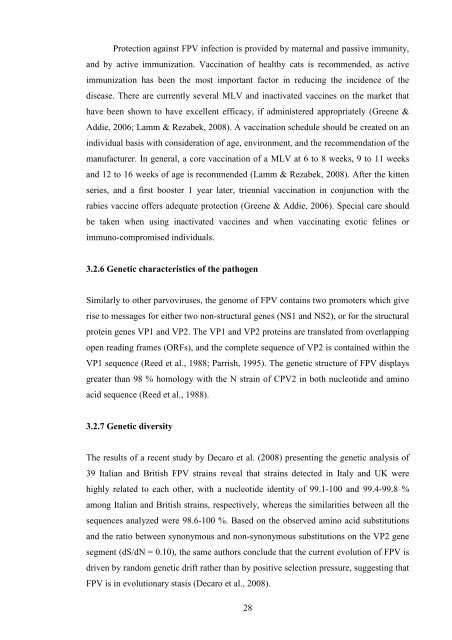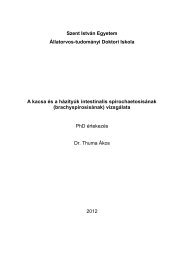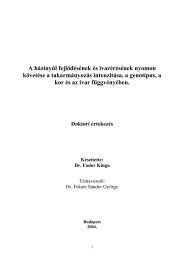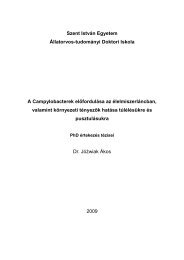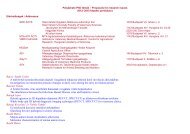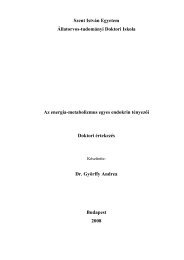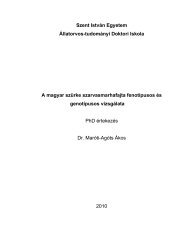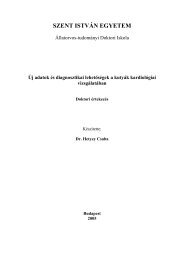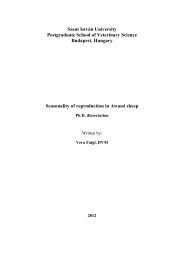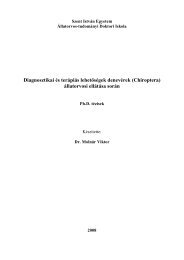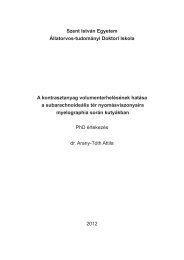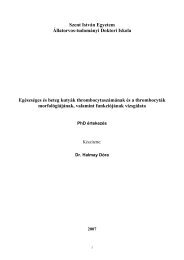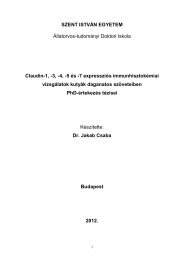PhD Thesis Demeter Zoltan
PhD Thesis Demeter Zoltan
PhD Thesis Demeter Zoltan
You also want an ePaper? Increase the reach of your titles
YUMPU automatically turns print PDFs into web optimized ePapers that Google loves.
Protection against FPV infection is provided by maternal and passive immunity,<br />
and by active immunization. Vaccination of healthy cats is recommended, as active<br />
immunization has been the most important factor in reducing the incidence of the<br />
disease. There are currently several MLV and inactivated vaccines on the market that<br />
have been shown to have excellent efficacy, if administered appropriately (Greene &<br />
Addie, 2006; Lamm & Rezabek, 2008). A vaccination schedule should be created on an<br />
individual basis with consideration of age, environment, and the recommendation of the<br />
manufacturer. In general, a core vaccination of a MLV at 6 to 8 weeks, 9 to 11 weeks<br />
and 12 to 16 weeks of age is recommended (Lamm & Rezabek, 2008). After the kitten<br />
series, and a first booster 1 year later, triennial vaccination in conjunction with the<br />
rabies vaccine offers adequate protection (Greene & Addie, 2006). Special care should<br />
be taken when using inactivated vaccines and when vaccinating exotic felines or<br />
immuno-compromised individuals.<br />
3.2.6 Genetic characteristics of the pathogen<br />
Similarly to other parvoviruses, the genome of FPV contains two promoters which give<br />
rise to messages for either two non-structural genes (NS1 and NS2), or for the structural<br />
protein genes VP1 and VP2. The VP1 and VP2 proteins are translated from overlapping<br />
open reading frames (ORFs), and the complete sequence of VP2 is contained within the<br />
VP1 sequence (Reed et al., 1988; Parrish, 1995). The genetic structure of FPV displays<br />
greater than 98 % homology with the N strain of CPV2 in both nucleotide and amino<br />
acid sequence (Reed et al., 1988).<br />
3.2.7 Genetic diversity<br />
The results of a recent study by Decaro et al. (2008) presenting the genetic analysis of<br />
39 Italian and British FPV strains reveal that strains detected in Italy and UK were<br />
highly related to each other, with a nucleotide identity of 99.1-100 and 99.4-99.8 %<br />
among Italian and British strains, respectively, whereas the similarities between all the<br />
sequences analyzed were 98.6-100 %. Based on the observed amino acid substitutions<br />
and the ratio between synonymous and non-synonymous substitutions on the VP2 gene<br />
segment (dS/dN = 0.10), the same authors conclude that the current evolution of FPV is<br />
driven by random genetic drift rather than by positive selection pressure, suggesting that<br />
FPV is in evolutionary stasis (Decaro et al., 2008).<br />
28


